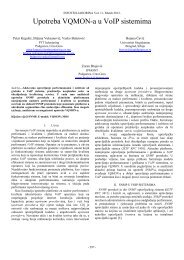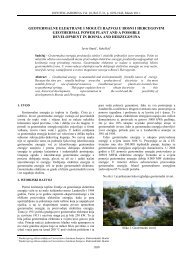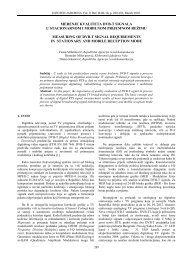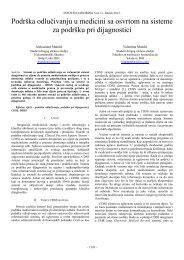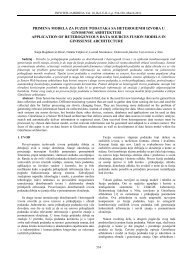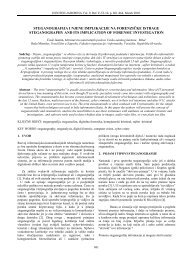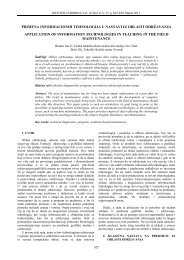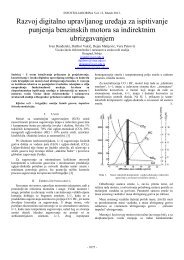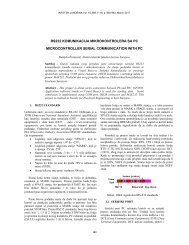numerical analysis of free upsetting cylinder using fem with ... - Infoteh
numerical analysis of free upsetting cylinder using fem with ... - Infoteh
numerical analysis of free upsetting cylinder using fem with ... - Infoteh
You also want an ePaper? Increase the reach of your titles
YUMPU automatically turns print PDFs into web optimized ePapers that Google loves.
is significantly simplified <strong>analysis</strong>. Flat die is specifieddisplacement <strong>of</strong> 10 mm as contour condition and it is equal tovertical displacement <strong>of</strong> die during experiment. Entirenonlinear <strong>analysis</strong> was completed after 213 increments.process, it is evident that the maximum stress reached inalmost the whole volume. Figures 4 and 5 show thedistribution <strong>of</strong> equivalent plastic strain.Based on distribution <strong>of</strong> displacement which is shown infigure 1 we can notice displacement on place <strong>of</strong> highestdiameter 13.1 mm, which means that highest diameter valueaccording FEM is 46.2 mm, while diameter <strong>of</strong> specimenobtained <strong>using</strong> the expetiment is 46.72 mm. It can be statedvery good matching results.Figure 4 - Distribution <strong>of</strong> equivalent plastic strain(displacement <strong>of</strong> die 8 mm)Figure 1 – Distribution <strong>of</strong> displacementIn experimental research displacement <strong>of</strong> flat die is 10.09mm and in that moment the crack observed by the wholeamount <strong>of</strong> compressed <strong>cylinder</strong>. In figures 2 and 3distribution <strong>of</strong> stress is shown for 8 and 10 mm diedisplacement. It can be observed that already during 8 mmdisplacement in big part <strong>of</strong> volume we obtained stress amount109.6 kN/cm 2 , which is the highest stress value and there arealready conditions for apperance <strong>of</strong> crack on contour.Figure 5 - Distribution <strong>of</strong> equivalent plastic strain(displacement <strong>of</strong> die 10 mm)It can be concluded that the zone <strong>of</strong> the largestdeformation properly distributed and that at the end <strong>of</strong> theprocess is well match the results <strong>of</strong> <strong>numerical</strong> <strong>analysis</strong> andexperiment. In the <strong>numerical</strong> <strong>analysis</strong> we have value φ e =1.5,and in experiment φ e =1.6024Figure 6 show dependence <strong>of</strong> the largest diameter <strong>of</strong> thedisplacement flat plate. It can be seen excellent agreement <strong>of</strong><strong>numerical</strong> and experimental results.s 0 1 2,5 5 8 10FEM-D 20,00 21,14 22,74 26,68 34,50 46,20Exp.-D 20,30 21,24 22,83 26,65 35,10 46,72Figure 2- Distribution <strong>of</strong> Von Mises`s stress(displacement <strong>of</strong> die 8 mm )D [mm]s [mm]Figure 3 - Distribution <strong>of</strong> Von Mises`s stress(displacement <strong>of</strong> die 10 mm )Figure 6 - Dependence <strong>of</strong> the diameter (D)<strong>of</strong> the displacement (s)When given the maximum displacement <strong>of</strong> flat solid die10 mm, which corresponds to the end <strong>of</strong> the <strong>upsetting</strong>240
3. EXPERIMENTAL RESEARCHEksperimental research were realized on specimen thatare made <strong>of</strong> steel (EN: 100Cr6). The specified material ischrome steel, and given that the balanced hardness valueachieved by the total cross section, is primarily intended formaking balls, rollers and roller bearing rings. Table 1 givesthe chemical composition.Table 1 - Chemical composition 100Cr6 [%]C Si Mn P S Cr≈ 1 0,25 0,35 0,025 0,025 1,5Generally, experimental research, whose results arepresented in this paper, can be divided into two parts: thedetermination <strong>of</strong> flow curve and upseting <strong>of</strong> cylindricalspecimen <strong>with</strong> flat dies.3.1 Flow curveDue to the lack <strong>of</strong> unique analytical connection betweenthe size <strong>of</strong> strain and specific deformation resistance, flowcurves can be determined only by experiment. For thispurpose, can be used large number <strong>of</strong> methods.The main advantage in defining the flow curves <strong>using</strong>method <strong>of</strong> <strong>upsetting</strong> <strong>cylinder</strong> is the possibility <strong>of</strong> achieving arelatively high values <strong>of</strong> strains <strong>of</strong> the specimen (over 100%). However, applying this method, due to the occurrence <strong>of</strong>friction on contact surfaces, there is the problem <strong>of</strong>generating bulk state <strong>of</strong> stress in <strong>of</strong> workpiece. Therefore,many authors use different ways to reduce the impact <strong>of</strong>friction force on the contact sheet to the scheme <strong>of</strong> workpiecestate <strong>of</strong> stress. One <strong>of</strong> the <strong>of</strong>ten encountered possibility is theuse <strong>of</strong> specimen <strong>with</strong> special shapes and adequate means forlubrication, thus the impact <strong>of</strong> friction is reduced tonegligible measure. In such circumstances the scheme <strong>of</strong>work-piece state <strong>of</strong> stress is very close linear form.In this paper for defining the flow curves Rastegajevmethodology is used, which is based on <strong>upsetting</strong> cylindricalspecimens <strong>with</strong> specific geometry between flat dies.We used three specimens whose shape is shown in figure7 <strong>with</strong> dimensions: d 0 = 20 mm, h 0 = 20 mm, u = 0,6 mm,t = 0,3 mm.ur 0Figure 7 – Specimen <strong>with</strong> skin front cavityThe process <strong>of</strong> <strong>free</strong> <strong>upsetting</strong> <strong>of</strong> <strong>cylinder</strong> <strong>using</strong> method <strong>of</strong>Rastegajev is incremental realized in several stages. From thefigure 8, where we can see pictures <strong>of</strong> specimens in different<strong>upsetting</strong> phases, it can be noticeable that specimen refraincylindrical shape from start to the end <strong>of</strong> <strong>upsetting</strong> process,which represents experimental verification <strong>of</strong> hypothesisth 0about strain equability <strong>of</strong> this specimen. Therefore, it can beconcluded that we obtained state <strong>of</strong> stress in specimen veryclose to axial state <strong>of</strong> stress, which was necessary conditionfor experimental determining <strong>of</strong> flow curve in senseminimization <strong>of</strong> contact friction impact.Figure 8 – Pictures <strong>of</strong> specimen in typical phases during<strong>cylinder</strong> <strong>upsetting</strong> <strong>using</strong> method RastegajevForming <strong>of</strong> specimen is realized on hydraulic press HP-6.3 MN Sack & Kiesselbach. Stearin are used as means forlubrication. In figure 9 we can see pictures <strong>of</strong> specimenbefore and after <strong>upsetting</strong> process in contact <strong>with</strong> tool <strong>with</strong>precisely noticable means for lubrication.Figure 9 – (a) Picture <strong>of</strong> specimen before <strong>upsetting</strong> process,(b) Picture <strong>of</strong> specimen after <strong>upsetting</strong> process [3]Principle <strong>of</strong> specific forming resistence determining isvery simple. Namely, starting from real assumption that axialstate <strong>of</strong> stress is obtained, specific forming resistence andcurrent area <strong>of</strong> specimen can be determined <strong>using</strong> followingexpressions:F d0⋅πh0K = ; A = ⋅(1)A 4 hWhen we know specimen height and its appropriateforming force we can calculate specific forming resistence.However, in order to define flow curve (K-φ), it is neseseryto know values <strong>of</strong> effective strain too. Effective strain, in thatcase, are determined <strong>using</strong> following expression:h oϕe= ln(2)hBased on determined paired values <strong>of</strong> specific formingresistence and efective strain, <strong>using</strong> statistic processing <strong>of</strong>results we obtain functional dependence K = K(φ) whosegraphic interpretation represents flow curve. We have variousapproximate forms <strong>of</strong> flow curve in dependence on straindegree. In this paper flow curve is approximated as Ludwik΄sdependence:K = K 0+ A ⋅ϕ(3)beApproximation <strong>of</strong> flow curve as shows expression (3) iscarried out accordingly values <strong>of</strong> specific forming resistanceK was coded by substraction value <strong>of</strong> K 0 from each value <strong>of</strong>K. Thus we obtained pairs (K-K 0 , φ e ) which wereapproximated in resumption by exponential regresivedependence in following form:241
ln( K − K0 ) = ln A + b lnϕ(4)eCoefficients A and b are determined according followingexpressions:nn∑lnϕei⋅ ∑ln( Ki− K )n0i= 1 i=1∑[ ln( Ki− K0) ⋅ lnϕei] −i=1b =n(5)2n⎛ ⎞⎜∑lnϕ⎟nei2 ⎝ i=1 ⎠∑ ln ϕei−i=1nA( K − K )nn∑lni ∑i= i== 1 10− b ⋅ lnϕeinFinaly, analytic form <strong>of</strong> flow curve for steel (EN: 100Cr6)is: K=423,5+658,06φ e 0,3412 [MPa].140012001000800600400K [M Pa]Ko =423,5K=423,5+658,06φ 0,3412Experimental curve(6)possible to <strong>upsetting</strong> certain phases considered monotonousprocess and applying the theory <strong>of</strong> plasticity to obtainexpressions for determining the components <strong>of</strong> stress.Figure 11 - Specimen <strong>with</strong> initial dimensionsØ 20 x 25 mm before and after crash [3]The deformation processes in cylindrical specimens in<strong>free</strong> <strong>upsetting</strong> processes, the identification <strong>of</strong> stresscomponents in the critical zone (outer surface <strong>of</strong> equatorialcross section <strong>of</strong> the specimen) is much easier, because in thiscase we have plane state <strong>of</strong> stress. As the component <strong>of</strong> theradial stress on the outer surface is zero (σ r = 0), it followsthat the r-axis direction at the same time and direction <strong>of</strong> theprincipal stress. Direction, which determines θ axis is also thedirection <strong>of</strong> the principal normal stress because it isconsidered that the flow <strong>of</strong> metal during <strong>upsetting</strong> process issymmetrically in relation to the longitudinal axis z, which inthese circumstances must represents a third direction <strong>of</strong> theprincipal normal stresses. In this paper, the identification <strong>of</strong>state <strong>of</strong> stress and strain was carried out by applying formingtheory, based on established geometry <strong>of</strong> the specimen in<strong>upsetting</strong> process stages.200φ e00 0,2 0,4 0,6 0,8 1 1,2 1,4Figure 10 – Flow curve for steel (EN: 100Cr6) [3]Approximative form <strong>of</strong> flow curve graph for steel (EN:100Cr6) in mathematical sense is monotonous increasingfunction, and shows an increase <strong>of</strong> forming resistance (K)<strong>with</strong> increasing degree <strong>of</strong> strain (φ). However, theexperimental flow curve (Figure 10) shows that after theachieved degree <strong>of</strong> strain φ ≥ 0.8 comes to the fall <strong>of</strong> thevalue <strong>of</strong> this parameter. Such behavior <strong>of</strong> materials at theexperimental research suggests certain changes in structurethat lead to a reduction in forming resistance when we haveincreasing the degree <strong>of</strong> strain.3.2 Upsetting <strong>of</strong> <strong>cylinder</strong> <strong>with</strong> flat diesThe second part <strong>of</strong> experimental research refers to theprocess <strong>of</strong> <strong>upsetting</strong> cylindrical specimen <strong>with</strong> flat dies. Inthis sense we used three sample sizes Ø 20 x 25 mm. Infigure 11 we can see the view <strong>of</strong> a specimen before and aftercrash <strong>with</strong> a clearly visible crack that marked the end <strong>of</strong> the<strong>upsetting</strong> process.Free <strong>upsetting</strong> <strong>of</strong> <strong>cylinder</strong> <strong>with</strong> flat dies belongs to agroup <strong>of</strong> plastic forming processes which aren't monotonous.However, <strong>using</strong> the incremental procedure <strong>of</strong> <strong>upsetting</strong>, it isFigure 12 – Scheme <strong>of</strong> specimen during<strong>free</strong> upseting processComponents <strong>of</strong> stress on the <strong>free</strong> surface <strong>of</strong> equatorialcross section <strong>of</strong> the specimen were determined on the basis <strong>of</strong>forming theory [4]:1−2 2⎡ ⎛1+2 ⋅α⎞ ⎛1+2 ⋅α⎞ ⎤σz= −σe ⎢1− ⎜ ⎟ + ⎜ ⎟ ⎥(7)⎢⎣⎝ 2 + α ⎠ ⎝ 2 + α ⎠ ⎥⎦⎛1+2 ⋅α⎞σ θ = σz ⎜ ⎟(8)⎝ 2 + α ⎠where α represents the ratio <strong>of</strong> increase <strong>of</strong> logarithmic strainin the direction z i θ axis.Equivalent strain for the case <strong>of</strong> incremental <strong>upsetting</strong>process <strong>of</strong> the cylindrical specimen is determined by the form(9):22ϕe = 1+α + α ϕ z(9)3242
The average values <strong>of</strong> the characteristic geometric sizes <strong>of</strong>the specimen and stress and strain components in stages <strong>of</strong><strong>upsetting</strong> process for the set <strong>of</strong> specimens <strong>with</strong> same startinggeometry are given in table 2.Table 2 - Displey <strong>of</strong> exprimental results [3]N 0h i [ mm] d i [mm] φ hi φ θi α i φ ei σ zi/ K σ θi / K0. 25,160 20,300 0,0000 0.0000 -------- 0,0000 -1.0000 0.00001. 24,190 20,720 -0,0393 0,0205 -0,5209 0,0393 -0,9858 0,02782. 23,080 21,240 -0,0863 0,0453 -0,5246 0,0863 -0,9832 0,03283. 22,170 21,745 -0,1265 0,0688 -0,5435 0,1267 -0,9698 0,05794. 20,200 22,830 -0,2196 0,1175 -0,5349 0,2198 -0,9759 0,04655. 18,360 24,020 -0,3151 0,1683 -0,5340 0,3153 -0,9766 0,04546. 16,720 25,335 -0,4086 0,2216 -0,5422 0,4091 -0,9707 0,05627. 15,130 26,645 -0,5086 0,2720 -0,5348 0,5090 -0,9760 0,04638. 13,650 28,020 -0,6115 0,3223 -0,5270 0,6118 -0,9815 0,03609. 12,460 29,460 -0,7027 0,3724 -0,5299 0,7032 -0,9794 0,039910. 11,200 31,130 -0,8093 0,4276 -0,5283 0,8098 -0,9806 0,037711. 10,030 32,865 -0,9197 0,4818 -0,5239 0,9200 -0,9837 0,031812. 8,880 35,100 -1,0415 0,5476 -0,5258 1,0419 -0,9824 0,034413. 7,900 37,075 -1,1584 0,6023 -0,5200 1,1587 -0,9864 0,026614. 7,030 39,305 -1,2751 0,6607 -0,5182 1,2754 -0,9877 0,024315. 6,120 42,130 -1,4137 0,7301 -0,5165 1,4139 -0,9888 0,022016. 5,070 46,720 -1,6019 0,8336 -0,5203 1,6024 -0,9862 0,02714. CONCLUSIONSIn the application <strong>of</strong> FEM to model the processes, inwhich plastic deformation are dominant, special attentionshould be paid to the modeling <strong>of</strong> contact conditions betweentool and specimen. At the end <strong>of</strong> the process when largedeformation occurs, the coefficient <strong>of</strong> friction is not constant.This is the main reason for discrepancies in results comparedto experiment, in addition variations <strong>of</strong> material model in the<strong>analysis</strong> <strong>using</strong> FEM. In the simulation processes that arenonlinear, the impact <strong>of</strong> finite element size on accuracy andconvergence <strong>of</strong> solutions is increased. Applying a smallersize <strong>of</strong> finite element to the model <strong>of</strong> these processes,computer calculations time for analyses is rapidly increases.This process <strong>of</strong>ten takes a few hours at the best performancecomputers, and <strong>of</strong>ten is the case <strong>of</strong> divergence <strong>of</strong> thesolutions.5. REFERENCE[1] E. Zahavi, D. Barlam: Nonlinear Problems in MachineDesign, CRC Press, 2001.[2] R. Liu, S. Quek: The Finite Element Method, NationalUniversity <strong>of</strong> Singapore, 2003.[3] M. Kraišnik: A Contribution to the MaterialsFormability Research in the Cylinder Cold UpsettingProcesses (in Serbian), MSc Thesis, University <strong>of</strong> NoviSad, 2008.[4] D. Vilotić,: Steel metal behaviour in different workingsystem <strong>of</strong> bulk cold deformation processes (in Serbian),University <strong>of</strong> Novi Sad, 1987.[5] N. Radić, M. Kraišnik, S. Trifković: Numericalexperimentaldetermination <strong>of</strong> stress-strain state due to<strong>upsetting</strong> process <strong>of</strong> cylindrical specimen, 27 th Danubia-Adria Symposium on Advances in ExperimentalMechanics, Wroclaw, Poland, 2010., pp. 151-152.[6] C. MacCormack, J. Monagnan: Failure <strong>analysis</strong> <strong>of</strong> coldforging dies <strong>using</strong> FEA, Journal <strong>of</strong> Materials ProcessingTehnology 117, 2001., pp. 209-215.[7] K. Saanouni: On the prediction <strong>of</strong> the ductile fracture inmetal forming, Engineering Fracture Mechanics 75,2008,. pp. 3545-3559.[8] H.Li, M. W. Fu, J. Lu, H. Yang: Ductile fracture:Experiments and computations, International Journal <strong>of</strong>Plasticity, 27, 2011., pp. 147-180. (Available online9 April 2010.)However,in the <strong>numerical</strong> <strong>analysis</strong> <strong>of</strong> <strong>free</strong> <strong>upsetting</strong><strong>cylinder</strong>, the model is divided into 6066 tetrahedral elements,which allowed a very good agreement between <strong>numerical</strong> andexperimental results. Discrepancies <strong>of</strong> results during theprocess are constant and approximately about 1%.243



